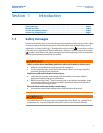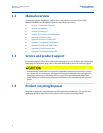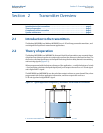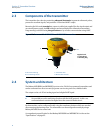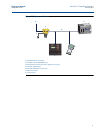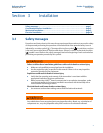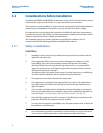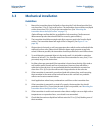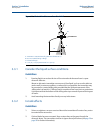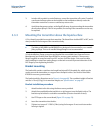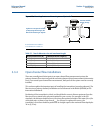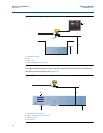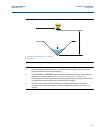
9
Reference Manual
IP2048/RM, Rev AA
Section 3: Installation
February 2015
3.3 Mechanical installation
Guidelines
1. Mount the transmitter above the liquid surface using the 2-inch thread provided, but
not closer than 12 in. (0,3 m) to the surface. The transmitter does not detect any liquid
surface closer than 12 in. (0,3 m) to the transmitter face. (See “Mounting the
transmitter above the liquid surface” on page 11).
Optional flanges and bracket kits are available to help mounting. (See Rosemount
Measurement product data sheet IP2045 for accessory part numbers.)
2. The transmitter should be mounted vertically to ensure a good echo from the liquid
surface. The transmitter beam half angle of the is 6 degrees. (See Figure 3-1 on
page 10).
3. Obstructions in the tank, or well, may generate echoes which can be confused with the
real liquid surface echo. Obstructions within the beam angle generate strong false
echoes. Wherever possible, the transmitter should be positioned to avoid false echoes.
4. To avoid detecting unwanted objects in the tank or well, it is advisable to maintain a
distance of at least 1.3 in. from the center line of the transmitter for every foot (11 cm
per meter) range to the obstruction.
5. No false echoes are generated if the transmitter is located near the side of the tank or
well, and the wall is smooth and free of protrusions. However, there will still be a
reduction in the echo size. It is recommended that the transmitter be mounted no
closer than 12 in. (0,3 m) to the wall to avoid a large reduction in the echo size.
6. If the transmitter is mounted in an enclosed tank with a domed top, avoid mounting
the transmitter in the center of the tank roof because this could act as a parabolic
reflector and create unwanted echoes.
7. Avoid applications where heavy condensation could form on the transmitter face.
8. If the transmitter is mounted in a stand-off or nozzle, the transmitter face should
protrude at least 0.2 in. (5 mm) into the tank. If this is not possible, see “Mounting the
transmitter above the liquid surface” on page 11).
9. If the transmitter is used in environments where direct sunlight can cause high surface
temperatures on exposed surfaces, a sun-shade is recommended.
10. Check that the maximum liquid level will not enter the 12-in. (0,3 m) blanking zone of
the transmitter.



